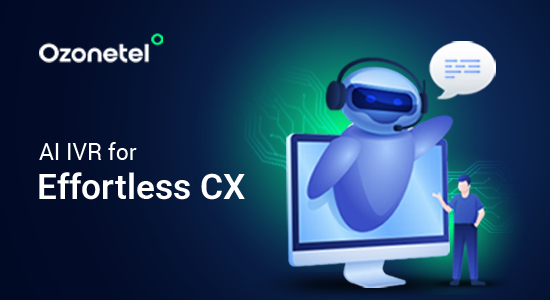- Resources
- Top Contact Center Tools to Scale Up Customer Support Operations
Top Contact Center Tools to Scale Up Customer Support Operations

Contact center technology refers to tools and software that help contact center agents and managers in doing their duties more efficiently while providing a better customer experience. This includes effective customer engagement through telephonic features, omnichannel connectors, and automations.
But, why should you invest in these contact center technologies? For starters, they help automate operations like call routing, which saves agents time and allows them to work more efficiently. Contact center technologies also provide cross-channel integrations, allowing agents to help clients via their preferred channels while carrying over the context of earlier encounters.
Basically, having the correct tools can help contact center teams perform more quickly and free up time to provide customers with the necessary support. So, let’s look at some of the best contact center technologies and how they might help your firm.
What Are Call Tracking Metrics?
Call tracking metrics are key indicators of the performance and efficiency of a call center. Metrics such as call duration, call volume, first-call resolution rate, and call source offer businesses granular details in the effectiveness of call-related activities. They help in identifying operational bottlenecks, evaluating agent performance, and measuring the overall effectiveness of marketing campaigns and customer service.
For example, by comparing missed and answered calls, you can find missed opportunities that can be quickly followed up on. Alternatively, analyzing call times and dates helps you in determining when your client’s business is most active.
Now, a lot of people confuse call-tracking metrics with key performance indicators (KPIs). While the two concepts are closely linked, they serve different purpose
Call metrics assess the performance of different business operations while KPIs measures progress towards achieving broader business activities. In other words, KPIs are time-bound goals that directly impact the business results.
7 Top Contact Center Tools to Scale your CX Operations
Some technologies that can help you scale up your contact center operations and deliver exceptional customer experiences are:
Cloud-Based Contact Center Solutions
The cloud-based contact center market is expected to grow from $26.2 billion in 2024 to $86.4 billion by 2029, with an annual growth rate of 26.9%. But what is the reason for this growth? Cloud-based solutions are highly flexible, allowing you to adapt quickly to changing demands without the headache of managing physical infrastructure.
These solutions also offer robust disaster recovery options, ensuring your contact center stays operational even if your primary location goes offline. Plus, they often come with automatic updates, keeping your technology always up-to-date without constant IT intervention.
Artificial Intelligence (AI) and Chatbots
AI-powered chatbots handle a large volume of customer interactions, from answering FAQs to processing simple transactions. They operate 24/7, reducing wait times and improving customer satisfaction.
A great example of this is Apple’s customer service chatbot that processes a user’s message for keywords and surfaces the most relevant content to meet the user’s needs. If the user isn’t satisfied with the automated support, the chatbot can quickly escalate the issue to a live agent.
Additionally, advanced AI can manage complex conversations, process refunds, and even upsell products based on customer history. AI also assists human agents by providing real-time suggestions and relevant information during calls, improving efficiency and call quality.
Omnichannel Communication Platforms
According to reports, 53% of customers have experienced fragmented interactions with customer support, highlighting the need for integrated communication.
An omnichannel system addresses this by unifying all communication channels (phone, email, chat, social media), allowing customers to switch between them seamlessly without losing context. This integration ensures consistent customer experience across all touchpoints.
With these platforms, agents can access full interaction history regardless of the channel, eliminating repetitive questions and enabling more personalized service. Omnichannel solutions also provide valuable insights into customer journeys and preferences across different platforms.
Analytics and Reporting Tools
Advanced analytics tools offer deep insights into contact center performance. They analyze customer sentiment, predict peak times, and identify at-risk customers. This helps reduce average call handle time by 40% and optimize conversion rates by nearly 50%.
Predictive analytics also help anticipate trends and proactively address potential issues. Moreover, real-time dashboards allow managers to monitor KPIs and make data-driven decisions quickly. These tools also facilitate performance evaluation and targeted agent training.
Workforce Management Solution
Workforce management systems optimize staffing levels based on historical data and AI-driven predictions. They account for factors like seasonality, marketing campaigns, and local events affecting call volumes.
For instance, Ship Sticks, a company specializing in the secure and reliable shipping of golf clubs, saw a 25% increase in baseline productivity after implementing a workforce management software.
Moreover, these solutions integrate with HR software to factor in employee availability and training schedules. Skills-based routing ensures that customer queries are matched with the most qualified available agents.
Basically, effective workforce management improves operational efficiency and reduces labor costs while maintaining service quality.
Interactive Voice Response (IVR) Systems
Modern IVR systems use natural language processing (NLP) to understand customer intent accurately. They integrate with CRM systems to provide personalized options based on caller history. This significantly reduces wait times and improves first-call resolution rates.
For example, Wakefit leveraged Ozonetel’s smart IVR solution to establish a robust delivery confirmation process. By automating updates on product delivery status, they reduced delivery failures by 10%, cutting both forward and reverse delivery costs.
Also, advanced IVRs can handle complex queries, reducing the need for agent intervention. Some systems can even employ voice biometrics for secure, efficient customer authentication.
Customer Relationship Management (CRM) Integration
As your customer base grows, keeping track of individual interactions becomes challenging. Integrating your contact center software with your CRM system creates a centralized hub of customer information.
For instance, HDB Financials enhanced operational efficiency by implementing an enterprise CRM integrated with the Ozonetel dialer. This integration allowed agents to access detailed lead information and automate real-time lead management, reducing turnaround time by 5% and increasing business opportunities.
This integration gives your agents instant access to customer histories, preferences, and previous interactions across all channels. The result? More personalized and efficient service, even as you handle an increasing volume of interactions.
Speech Analytics
Managing customer interactions effectively can be a challenge, especially when dealing with high call volumes. Speech analytics simplifies this by automatically analyzing customer conversations in real-time. This technology identifies keywords, phrases, and even the emotional tone of the caller, giving your agents actionable insights during the call.
For instance, Ozonetel’s Speech Analytics solution helped NHA obtain deep sentiment analysis and automate agent scoring, enhancing agent training and improving the overall beneficiary experience. Also, within the first quarter of deployment, NHA’s contact center saved an average of 30 hours per month.
Customer Journey Analytics
A recent CX survey revealed that 20% of respondents identified measuring customer experience initiatives as a significant challenge. Customer journey analytics directly addresses this by enabling organizations to measure the ROI on CX initiatives.
Basically, they provide a comprehensive view of every touchpoint a customer interacts with, from their first contact to the final resolution. By tracking and analyzing this journey, you can identify pain points, optimize processes, and personalize interactions to meet customer expectations. This ensures that every step of the customer journey is smooth and tailored to their needs.
Contact Center Technology Implementation: Key Challenges
Implementing new contact center technologies, while beneficial, often presents significant challenges such as:
Resistance to Change
Employees often view new technologies as threats to job security or disruptions to familiar workflows. This resistance can manifest as reduced productivity, increased errors, or outright refusal to adopt new systems.
It’s particularly prevalent in long-established teams accustomed to specific processes. Overcoming this resistance requires a strategic approach that emphasizes transparency, involvement, and gradual implementation.
Solution:
- Communicate the benefits clearly, emphasizing how the technology will support rather than replace staff.
- Involve employees in the selection and implementation process to increase buy-in.
- Implement changes gradually, allowing time for adaptation.
- Cost of Implementation
The financial impact of implementing new contact center technologies extends beyond the initial purchase. It includes costs for installation, customization, training, and potential downtime during transition.
For smaller businesses or those with tight budgets, these expenses can be restrictive. However, failing to upgrade can lead to long-term inefficiencies and competitive disadvantages.
Solution:
- Conduct a thorough cost-benefit analysis to justify the investment.
- Consider phased implementation to spread costs over time.
- Explore cloud-based solutions with subscription models to reduce upfront costs.
Training and Skill Gaps
New technologies often require specialized skills that existing staff may lack. This gap can lead to underutilization of new systems or increased errors during the transition period. The challenge escalates when technologies are complex or significantly different from previous systems.
Solution:
- Develop comprehensive training programs tailored to different roles and skill levels.
- Utilize e-learning platforms for continuous, flexible training.
- Identify and train ‘champion’ users who can support their peers.
Integration with Existing Systems
Many contact centers operate with a mix of legacy and modern systems. And introducing new technologies into this environment can create compatibility issues, data silos, or workflow disruptions. As a result, seamless integration is important for maintaining operational efficiency and data consistency.
Solution:
- Prioritize solutions with robust API capabilities for easier integration.
- Consider middleware solutions to bridge gaps between new and existing systems.
- Plan for data migration and system compatibility early in the implementation process.
Data Security and Compliance
As contact centers handle sensitive customer information, any new technology introduces potential security risks. This is particularly critical in industries with strict regulatory requirements like healthcare or finance. Hence, new systems must not only be secure themselves but also integrate securely with existing infrastructure.
Solution:
- Conduct thorough security audits of new systems before implementation.
- Ensure vendors comply with relevant industry standards and regulations.
- Implement strong data governance policies and regular security training for staff.
Measuring ROI
Quantifying the return on investment for new contact center technologies can be complex. While some benefits, like reduced call handling times, are easily measurable, others, such as improved customer satisfaction or employee engagement, are more difficult to quantify. Additionally, the full impact of new technologies may not be immediately apparent, requiring long-term tracking and analysis.
Solution:
- Establish clear, measurable KPIs before implementation.
- Use analytics tools to track performance improvements over time.
- Regularly review and report on both quantitative and qualitative benefits.
Conclusion
As customer expectations continue to rise and competition intensifies, businesses must leverage advanced technologies to stay ahead. These technologies enable organizations to handle higher volumes of interactions without compromising quality, while also providing valuable insights for continuous improvement.
However, successful implementation requires careful planning and a strategic approach. So, you must assess your specific needs and choose technologies that align with their goals. By doing so, you can not only meet current demands but also position themselves for future growth and success
Final thoughts
By choosing the right AI-powered solution, companies can significantly improve customer satisfaction, reduce operational costs, and gain valuable insights into their service performance. And as you decide on the AI call center software to deploy in your organization, consider Ozonetel’s comprehensive suite of AI-powered tools.
Ozonetel offers a robust platform that integrates seamlessly with your existing systems, providing advanced features like intelligent routing, sentiment analysis, and real-time agent assistance. With its user-friendly interface and quick
Want to see what Ozonetel can do for your company? Sign up today for a free 7-day trial.
Prashanth Kancherla
Chief Operating Officer, Ozonetel Communications
Over the past decade, Prashanth has worked with 3000+ customer experience and contact center leaders...
Chief Operating Officer, Ozonetel Communications
Over the past decade, Prashanth has worked with 3000+ customer experience and contact center leaders to comprehensively understand the need for effective and efficient customer communications at every step of their journey with a brand. Deeply embedded in today’s CCaaS ecosystem, he has been instrumental in Ozonetel's growth and contributed in various roles including product management, sales, and solution architecture.
Frequently Asked Questions
To scale a contact center effectively, assess current operations and automate routine tasks with AI and chatbots to handle increased volume. Then, invest in scalable cloud-based systems and train additional staff to ensure consistent service quality as demand grows.
Contact centers utilize technologies like Automatic Call Distribution (ACD) for efficient call routing, Interactive Voice Response (IVR) systems for self-service, and Customer Relationship Management (CRM) software to manage interactions. Additionally, AI-driven analytics and omnichannel platforms are important for enhancing customer experience and operational efficiency.
Improving service levels in a contact center involves optimizing workforce management through accurate forecasting and scheduling to reduce wait times. Additionally, continuously training agents and leveraging real-time analytics can help maintain high service standards.
The four core elements of a contact center include the agents who interact with customers, the technology platforms like ACD and CRM that facilitate operations, the processes and workflows that guide service delivery, and the metrics that measure performance and efficiency. These elements work together to ensure a smooth, effective customer experience.







